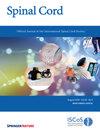美国潜水相关脊柱损伤的发生率和趋势以及与脊髓损伤相关的危险因素。
IF 2.2
4区 医学
Q3 CLINICAL NEUROLOGY
引用次数: 0
摘要
研究设计:回顾性纵向队列研究。目的:描述:(1)美国潜水相关脊柱损伤(DRSI)和潜水相关脊髓损伤(DRSCI)的发生率和趋势;(2)与DRSCI相关的危险因素。背景:使用超过1.61亿患者的大型、全国性、多保险管理数据集,识别并描述了那些遭受DRSIs的患者。方法:对2010-2021年发生DRSIs的患者进行分析。估计年变化百分比(EAPC)采用对数线性回归计算。对于DRSCI患者,采用多变量logistic回归评估危险因素。结果:3829例DRSIs患者中,颈椎受累最多(53.0%)。在研究期间,颈椎、胸椎和腰椎DRSIs的EAPCs显著降低(分别为-4.69、-6.81和-4.88%);结论:近年来,美国颈椎、胸椎和腰椎的DRSIs发生率显著下降。然而,DRSCI的不显著趋势突出了持续的公共卫生倡议的重要性。在DRSCI患者中,确定了几个独特的风险因素,为改进当前的潜水损伤预防计划奠定了基础。本文章由计算机程序翻译,如有差异,请以英文原文为准。

The incidence and trends of diving-related spine injuries in the United States and risk factors associated with spinal cord injury
Retrospective longitudinal cohort study. To characterize: (1) incidence and trends of diving-related spine injuries (DRSI) and diving-related spinal cord injury (DRSCI) in the United States and (2) risk-factors associated with DRSCI. Using a large, national, multi-insurance administrative dataset of over 161 million patients, those who suffered a DRSIs were identified and characterized. Persons who suffered a DRSIs were analyzed from 2010–2021. Estimated annual percentage change (EAPC) was calculated by log-linear regression. For those with DRSCI, risk-factors were assessed by multivariable logistic regression. Of 3829 persons who suffered DRSIs, the cervical spine was most frequently involved (53.0%). EAPCs of DRSIs at the cervical, thoracic, and lumbar spine significantly decreased over the studied years (−4.69, −6.81, and −4.88%, respectively; p < 0.05 for all), while DRSCI demonstrated a nonsignificant trend (p = 0.081). Among the 629 (16.4%) with DRSCI, risk-factors included: prior cervical spine surgery (OR 13.31, p < 0.001), history of cervical spondylolisthesis (OR 5.36, p < 0.001), male sex (OR 2.69, p < 0.001), history of cervical stenosis (OR 2.26, p < 0.001), coastal states (OR 1.38, p = 0.012), higher Elixhauser Comorbidity Index (OR 1.15, p < 0.001), and older age (OR 1.01, p = 0.029). The rate of DRSIs of the cervical, thoracic, and lumbar spine has significantly decreased in recent years in the United States. However, the nonsignificant trend in DRSCI highlights the importance of continued public health initiatives. Among those with DRSCI, several unique risk-factors were identified, laying the foundation for the refinement of current diving injury prevention programs.
求助全文
通过发布文献求助,成功后即可免费获取论文全文。
去求助
来源期刊

Spinal cord
医学-临床神经学
CiteScore
4.50
自引率
9.10%
发文量
142
审稿时长
2 months
期刊介绍:
Spinal Cord is a specialised, international journal that has been publishing spinal cord related manuscripts since 1963. It appears monthly, online and in print, and accepts contributions on spinal cord anatomy, physiology, management of injury and disease, and the quality of life and life circumstances of people with a spinal cord injury. Spinal Cord is multi-disciplinary and publishes contributions across the entire spectrum of research ranging from basic science to applied clinical research. It focuses on high quality original research, systematic reviews and narrative reviews.
Spinal Cord''s sister journal Spinal Cord Series and Cases: Clinical Management in Spinal Cord Disorders publishes high quality case reports, small case series, pilot and retrospective studies perspectives, Pulse survey articles, Point-couterpoint articles, correspondences and book reviews. It specialises in material that addresses all aspects of life for persons with spinal cord injuries or disorders. For more information, please see the aims and scope of Spinal Cord Series and Cases.
 求助内容:
求助内容: 应助结果提醒方式:
应助结果提醒方式:


